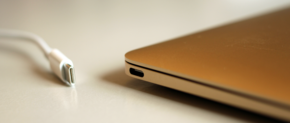
USB
Standard for computer data connections / From Wikipedia, the free encyclopedia
Dear Wikiwand AI, let's keep it short by simply answering these key questions:
Can you list the top facts and stats about USB?
Summarize this article for a 10 year old
Universal Serial Bus (USB) is an industry standard that allows data exchange and delivery of power between many types of electronics. It specifies its architecture, in particular its physical interface, and communication protocols for data transfer and power delivery to and from hosts, such as personal computers, to and from peripheral devices, e.g. displays, keyboards, and mass storage devices, and to and from intermediate hubs, which multiply the number of a host's ports.[2]
 | |||
 The current connector for USB, Thunderbolt, and other protocols, USB-C (plug and receptacle shown) | |||
| Type | Bus | ||
|---|---|---|---|
| Production history | |||
| Designer | |||
| Designed | January 1996; 28 years ago (1996-01) | ||
| Produced | Since May 1996[1] | ||
| Superseded | Serial port, parallel port, game port, Apple Desktop Bus, PS/2 port, and FireWire (IEEE 1394) | ||
USB was originally designed to standardize the connection of peripherals to computers, replacing various interfaces such as serial ports, parallel ports, game ports, and ADB ports.[3] Prior versions of USB became commonplace on a wide range of devices, such as keyboards, mice, cameras, printers, scanners, flash drives, smartphones, game consoles, and power banks.[4] It has evolved into a standard to replace virtually all common ports on computers, mobile devices, peripherals, power supplies, and manifold other small electronics.
In the current standard, the USB-C connector replaces the many various connectors for power (up to 240 W), displays (e.g. DisplayPort, HDMI), and many other uses, as well as all previous USB connectors.
As of 2024,[update] USB consists of four generations of specifications: USB 1.x, USB 2.0, USB 3.x, and USB4. USB4 enhances the data transfer and power delivery functionality with
... a connection-oriented, tunneling architecture designed to combine multiple protocols onto a single physical interface so that the total speed and performance of the USB4 Fabric can be dynamically shared.[2]
USB4 particularly supports the tunneling of the Thunderbolt 3 protocols, namely PCI Express (PCIe, load/store interface) and DisplayPort (display interface). USB4 also adds host-to-host interfaces.[2]
Each specification sub-version supports different signaling rates from 1.5 and 12 Mbit/s total in USB 1.0 to 80 Gbit/s (in each direction) in USB4.[5][6][7][2] USB also provides power to peripheral devices; the latest versions of the standard extend the power delivery limits for battery charging and devices requiring up to 240 watts (USB Power Delivery (USB-PD)).[8] Over the years, USB(-PD) has been adopted as the standard power supply and charging format for many mobile devices, such as mobile phones, reducing the need for proprietary chargers.[9]